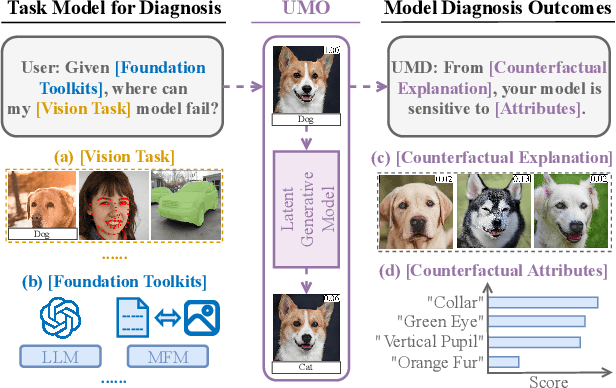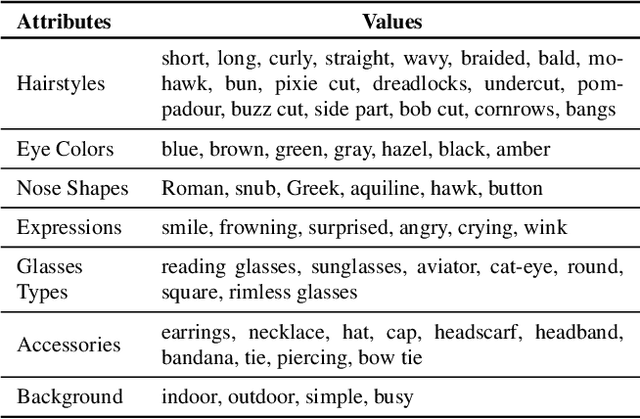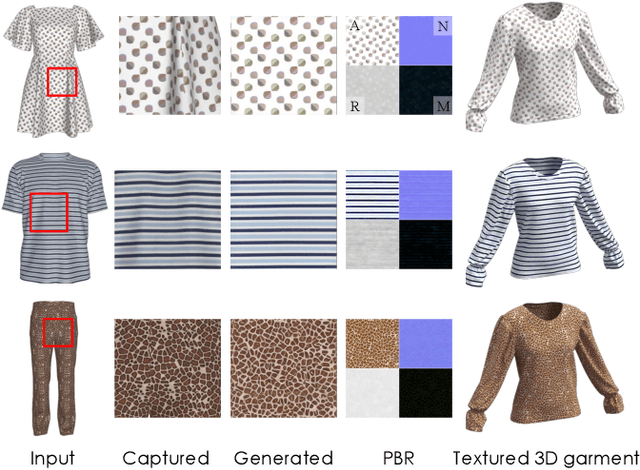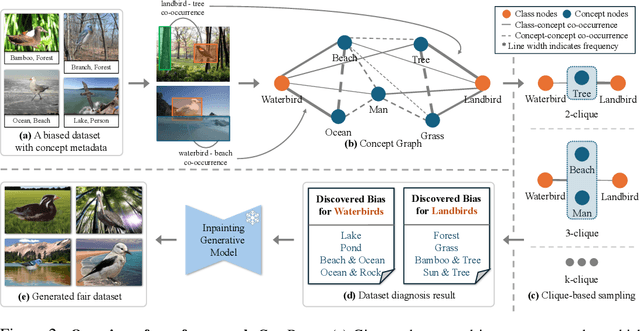Fernando De la Torre
LightSwitch: Multi-view Relighting with Material-guided Diffusion
Aug 08, 2025Abstract:Recent approaches for 3D relighting have shown promise in integrating 2D image relighting generative priors to alter the appearance of a 3D representation while preserving the underlying structure. Nevertheless, generative priors used for 2D relighting that directly relight from an input image do not take advantage of intrinsic properties of the subject that can be inferred or cannot consider multi-view data at scale, leading to subpar relighting. In this paper, we propose Lightswitch, a novel finetuned material-relighting diffusion framework that efficiently relights an arbitrary number of input images to a target lighting condition while incorporating cues from inferred intrinsic properties. By using multi-view and material information cues together with a scalable denoising scheme, our method consistently and efficiently relights dense multi-view data of objects with diverse material compositions. We show that our 2D relighting prediction quality exceeds previous state-of-the-art relighting priors that directly relight from images. We further demonstrate that LightSwitch matches or outperforms state-of-the-art diffusion inverse rendering methods in relighting synthetic and real objects in as little as 2 minutes.
Adapting Vehicle Detectors for Aerial Imagery to Unseen Domains with Weak Supervision
Jul 28, 2025Abstract:Detecting vehicles in aerial imagery is a critical task with applications in traffic monitoring, urban planning, and defense intelligence. Deep learning methods have provided state-of-the-art (SOTA) results for this application. However, a significant challenge arises when models trained on data from one geographic region fail to generalize effectively to other areas. Variability in factors such as environmental conditions, urban layouts, road networks, vehicle types, and image acquisition parameters (e.g., resolution, lighting, and angle) leads to domain shifts that degrade model performance. This paper proposes a novel method that uses generative AI to synthesize high-quality aerial images and their labels, improving detector training through data augmentation. Our key contribution is the development of a multi-stage, multi-modal knowledge transfer framework utilizing fine-tuned latent diffusion models (LDMs) to mitigate the distribution gap between the source and target environments. Extensive experiments across diverse aerial imagery domains show consistent performance improvements in AP50 over supervised learning on source domain data, weakly supervised adaptation methods, unsupervised domain adaptation methods, and open-set object detectors by 4-23%, 6-10%, 7-40%, and more than 50%, respectively. Furthermore, we introduce two newly annotated aerial datasets from New Zealand and Utah to support further research in this field. Project page is available at: https://humansensinglab.github.io/AGenDA
GarmentCrafter: Progressive Novel View Synthesis for Single-View 3D Garment Reconstruction and Editing
Mar 11, 2025Abstract:We introduce GarmentCrafter, a new approach that enables non-professional users to create and modify 3D garments from a single-view image. While recent advances in image generation have facilitated 2D garment design, creating and editing 3D garments remains challenging for non-professional users. Existing methods for single-view 3D reconstruction often rely on pre-trained generative models to synthesize novel views conditioning on the reference image and camera pose, yet they lack cross-view consistency, failing to capture the internal relationships across different views. In this paper, we tackle this challenge through progressive depth prediction and image warping to approximate novel views. Subsequently, we train a multi-view diffusion model to complete occluded and unknown clothing regions, informed by the evolving camera pose. By jointly inferring RGB and depth, GarmentCrafter enforces inter-view coherence and reconstructs precise geometries and fine details. Extensive experiments demonstrate that our method achieves superior visual fidelity and inter-view coherence compared to state-of-the-art single-view 3D garment reconstruction methods.
GAS: Generative Avatar Synthesis from a Single Image
Feb 10, 2025Abstract:We introduce a generalizable and unified framework to synthesize view-consistent and temporally coherent avatars from a single image, addressing the challenging problem of single-image avatar generation. While recent methods employ diffusion models conditioned on human templates like depth or normal maps, they often struggle to preserve appearance information due to the discrepancy between sparse driving signals and the actual human subject, resulting in multi-view and temporal inconsistencies. Our approach bridges this gap by combining the reconstruction power of regression-based 3D human reconstruction with the generative capabilities of a diffusion model. The dense driving signal from the initial reconstructed human provides comprehensive conditioning, ensuring high-quality synthesis faithful to the reference appearance and structure. Additionally, we propose a unified framework that enables the generalization learned from novel pose synthesis on in-the-wild videos to naturally transfer to novel view synthesis. Our video-based diffusion model enhances disentangled synthesis with high-quality view-consistent renderings for novel views and realistic non-rigid deformations in novel pose animation. Results demonstrate the superior generalization ability of our method across in-domain and out-of-domain in-the-wild datasets. Project page: https://humansensinglab.github.io/GAS/
LlaMADRS: Prompting Large Language Models for Interview-Based Depression Assessment
Jan 07, 2025Abstract:This study introduces LlaMADRS, a novel framework leveraging open-source Large Language Models (LLMs) to automate depression severity assessment using the Montgomery-Asberg Depression Rating Scale (MADRS). We employ a zero-shot prompting strategy with carefully designed cues to guide the model in interpreting and scoring transcribed clinical interviews. Our approach, tested on 236 real-world interviews from the Context-Adaptive Multimodal Informatics (CAMI) dataset, demonstrates strong correlations with clinician assessments. The Qwen 2.5--72b model achieves near-human level agreement across most MADRS items, with Intraclass Correlation Coefficients (ICC) closely approaching those between human raters. We provide a comprehensive analysis of model performance across different MADRS items, highlighting strengths and current limitations. Our findings suggest that LLMs, with appropriate prompting, can serve as efficient tools for mental health assessment, potentially increasing accessibility in resource-limited settings. However, challenges remain, particularly in assessing symptoms that rely on non-verbal cues, underscoring the need for multimodal approaches in future work.
Texture- and Shape-based Adversarial Attacks for Vehicle Detection in Synthetic Overhead Imagery
Dec 20, 2024



Abstract:Detecting vehicles in aerial images can be very challenging due to complex backgrounds, small resolution, shadows, and occlusions. Despite the effectiveness of SOTA detectors such as YOLO, they remain vulnerable to adversarial attacks (AAs), compromising their reliability. Traditional AA strategies often overlook the practical constraints of physical implementation, focusing solely on attack performance. Our work addresses this issue by proposing practical implementation constraints for AA in texture and/or shape. These constraints include pixelation, masking, limiting the color palette of the textures, and constraining the shape modifications. We evaluated the proposed constraints through extensive experiments using three widely used object detector architectures, and compared them to previous works. The results demonstrate the effectiveness of our solutions and reveal a trade-off between practicality and performance. Additionally, we introduce a labeled dataset of overhead images featuring vehicles of various categories. We will make the code/dataset public upon paper acceptance.
Unsupervised Model Diagnosis
Oct 08, 2024



Abstract:Ensuring model explainability and robustness is essential for reliable deployment of deep vision systems. Current methods for evaluating robustness rely on collecting and annotating extensive test sets. While this is common practice, the process is labor-intensive and expensive with no guarantee of sufficient coverage across attributes of interest. Recently, model diagnosis frameworks have emerged leveraging user inputs (e.g., text) to assess the vulnerability of the model. However, such dependence on human can introduce bias and limitation given the domain knowledge of particular users. This paper proposes Unsupervised Model Diagnosis (UMO), that leverages generative models to produce semantic counterfactual explanations without any user guidance. Given a differentiable computer vision model (i.e., the target model), UMO optimizes for the most counterfactual directions in a generative latent space. Our approach identifies and visualizes changes in semantics, and then matches these changes to attributes from wide-ranging text sources, such as dictionaries or language models. We validate the framework on multiple vision tasks (e.g., classification, segmentation, keypoint detection). Extensive experiments show that our unsupervised discovery of semantic directions can correctly highlight spurious correlations and visualize the failure mode of target models without any human intervention.
FabricDiffusion: High-Fidelity Texture Transfer for 3D Garments Generation from In-The-Wild Clothing Images
Oct 02, 2024

Abstract:We introduce FabricDiffusion, a method for transferring fabric textures from a single clothing image to 3D garments of arbitrary shapes. Existing approaches typically synthesize textures on the garment surface through 2D-to-3D texture mapping or depth-aware inpainting via generative models. Unfortunately, these methods often struggle to capture and preserve texture details, particularly due to challenging occlusions, distortions, or poses in the input image. Inspired by the observation that in the fashion industry, most garments are constructed by stitching sewing patterns with flat, repeatable textures, we cast the task of clothing texture transfer as extracting distortion-free, tileable texture materials that are subsequently mapped onto the UV space of the garment. Building upon this insight, we train a denoising diffusion model with a large-scale synthetic dataset to rectify distortions in the input texture image. This process yields a flat texture map that enables a tight coupling with existing Physically-Based Rendering (PBR) material generation pipelines, allowing for realistic relighting of the garment under various lighting conditions. We show that FabricDiffusion can transfer various features from a single clothing image including texture patterns, material properties, and detailed prints and logos. Extensive experiments demonstrate that our model significantly outperforms state-to-the-art methods on both synthetic data and real-world, in-the-wild clothing images while generalizing to unseen textures and garment shapes.
Visual Data Diagnosis and Debiasing with Concept Graphs
Sep 26, 2024



Abstract:The widespread success of deep learning models today is owed to the curation of extensive datasets significant in size and complexity. However, such models frequently pick up inherent biases in the data during the training process, leading to unreliable predictions. Diagnosing and debiasing datasets is thus a necessity to ensure reliable model performance. In this paper, we present CONBIAS, a novel framework for diagnosing and mitigating Concept co-occurrence Biases in visual datasets. CONBIAS represents visual datasets as knowledge graphs of concepts, enabling meticulous analysis of spurious concept co-occurrences to uncover concept imbalances across the whole dataset. Moreover, we show that by employing a novel clique-based concept balancing strategy, we can mitigate these imbalances, leading to enhanced performance on downstream tasks. Extensive experiments show that data augmentation based on a balanced concept distribution augmented by CONBIAS improves generalization performance across multiple datasets compared to state-of-the-art methods. We will make our code and data publicly available.
Multimodal Fusion with LLMs for Engagement Prediction in Natural Conversation
Sep 13, 2024Abstract:Over the past decade, wearable computing devices (``smart glasses'') have undergone remarkable advancements in sensor technology, design, and processing power, ushering in a new era of opportunity for high-density human behavior data. Equipped with wearable cameras, these glasses offer a unique opportunity to analyze non-verbal behavior in natural settings as individuals interact. Our focus lies in predicting engagement in dyadic interactions by scrutinizing verbal and non-verbal cues, aiming to detect signs of disinterest or confusion. Leveraging such analyses may revolutionize our understanding of human communication, foster more effective collaboration in professional environments, provide better mental health support through empathetic virtual interactions, and enhance accessibility for those with communication barriers. In this work, we collect a dataset featuring 34 participants engaged in casual dyadic conversations, each providing self-reported engagement ratings at the end of each conversation. We introduce a novel fusion strategy using Large Language Models (LLMs) to integrate multiple behavior modalities into a ``multimodal transcript'' that can be processed by an LLM for behavioral reasoning tasks. Remarkably, this method achieves performance comparable to established fusion techniques even in its preliminary implementation, indicating strong potential for further research and optimization. This fusion method is one of the first to approach ``reasoning'' about real-world human behavior through a language model. Smart glasses provide us the ability to unobtrusively gather high-density multimodal data on human behavior, paving the way for new approaches to understanding and improving human communication with the potential for important societal benefits. The features and data collected during the studies will be made publicly available to promote further research.
 Add to Chrome
Add to Chrome Add to Firefox
Add to Firefox Add to Edge
Add to Edge